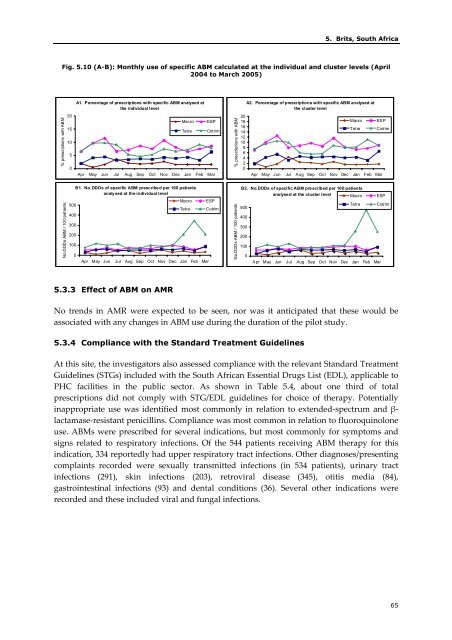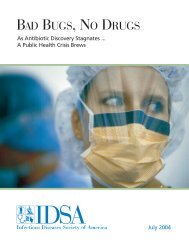Community-Based Surveillance of Antimicrobial Use and ...
Community-Based Surveillance of Antimicrobial Use and ...
Community-Based Surveillance of Antimicrobial Use and ...
- No tags were found...
Create successful ePaper yourself
Turn your PDF publications into a flip-book with our unique Google optimized e-Paper software.
5. Brits, South AfricaFig. 5.10 (A-B): Monthly use <strong>of</strong> specific ABM calculated at the individual <strong>and</strong> cluster levels (April2004 to March 2005)% prescriptions with ABM20151050A1. Percentage <strong>of</strong> prescriptions with specific ABM analysed atthe individual levelMacroTetraESPCotrimApr May Jun Jul Aug Sep Oct Nov Dec Jan Feb Mar% prescriptions with ABM20181614121086420A2. Percentage <strong>of</strong> prescriptions with specific ABM analysed atthe cluster levelMacroTetraApr May Jun Jul Aug Sep Oct Nov Dec Jan Feb MarESPCotrimNo.DDDs ABM / 100 patients5004003002001000B1. No.DDDs <strong>of</strong> specific ABM prescribed per 100 patientsanalysed at the individual levelMacroTetraApr May Jun Jul Aug Sep Oct Nov Dec Jan Feb MarESPCotrimNo.DDDs ABM / 100 patientsB2. No.DDDs <strong>of</strong> specific ABM prescribed per 100 patientsanalysed at the cluster level Macro ESP500400Tetra Cotrim3002001000Apr May Jun Jul Aug Sep Oct Nov Dec Jan Feb Mar5.3.3 Effect <strong>of</strong> ABM on AMRNo trends in AMR were expected to be seen, nor was it anticipated that these would beassociated with any changes in ABM use during the duration <strong>of</strong> the pilot study.5.3.4 Compliance with the St<strong>and</strong>ard Treatment GuidelinesAt this site, the investigators also assessed compliance with the relevant St<strong>and</strong>ard TreatmentGuidelines (STGs) included with the South African Essential Drugs List (EDL), applicable toPHC facilities in the public sector. As shown in Table 5.4, about one third <strong>of</strong> totalprescriptions did not comply with STG/EDL guidelines for choice <strong>of</strong> therapy. Potentiallyinappropriate use was identified most commonly in relation to extended‐spectrum <strong>and</strong> β‐lactamase‐resistant penicillins. Compliance was most common in relation to fluoroquinoloneuse. ABMs were prescribed for several indications, but most commonly for symptoms <strong>and</strong>signs related to respiratory infections. Of the 544 patients receiving ABM therapy for thisindication, 334 reportedly had upper respiratory tract infections. Other diagnoses/presentingcomplaints recorded were sexually transmitted infections (in 534 patients), urinary tractinfections (291), skin infections (203), retroviral disease (345), otitis media (84),gastrointestinal infections (93) <strong>and</strong> dental conditions (36). Several other indications wererecorded <strong>and</strong> these included viral <strong>and</strong> fungal infections.65




